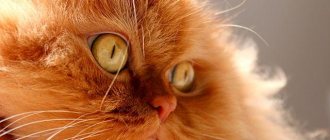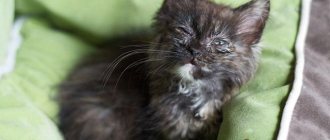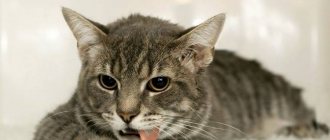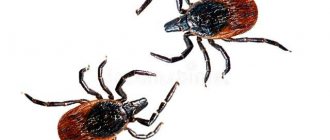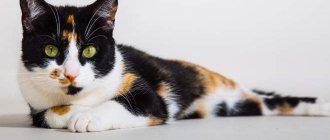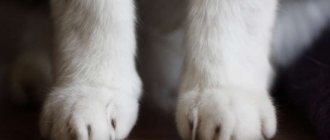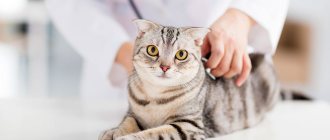It is not difficult to determine that your pet has become worse able to see or is completely blind. It is necessary to carefully monitor his condition and behavior. But you need not only to understand that the animal is blind, but also to find out what caused this condition.
Blindness does not always develop quickly. In some cases, against the background of serious pathologies, vision loss occurs gradually. Therefore, signs also appear slowly. It is worth remembering that blindness in a cat can be either reversible or irreversible. Blindness is also divided into partial and complete.
To know when to seek veterinary help, you need to monitor for symptoms.
Unsteady gait
First on the list of signs indicating the development of blindness in a cat is an unsteady gait. Owners of blind cats know firsthand that their pets, deprived of the ability to see normally, are able to live varied and quite happy lives. Remaining blind, the cat will not suffer, but will be able to adapt to life. The fact is that with age, all cats sooner or later begin to go blind as a result of the development of degenerative senile processes.
Domestic cats have human-like vision. The difference is the color of the image and twilight vision. Cats are not able to normally focus their gaze on nearby objects. At the same time, objects located at a distance are visualized much better. This explains the fact that a cat can be completely indifferent to its favorite toy that lies nearby.
For most people, after 40 years of age, their vision begins to rapidly deteriorate. Therefore, a person turns to an ophthalmologist, who prescribes the wearing of glasses, at least for reading. Domestic cats, after 5 years, begin to see worse. The reason for this is a change in the flexibility of the lens, causing clouding. This leads to a disruption in the ability to focus on objects, regardless of their location.
Vision problems that come on suddenly can cause a change in gait. Unsteady walking occurs in cases where vision loss is caused by sudden changes in the lens, vitreous body or retina.
How to care for a sick pet: features
Blind cats that live in an apartment or house often adapt to this situation. It is important for the owner to follow certain rules and, of course, love his pet. First of all, you should give up free range. If your cat likes to walk outside, this can only be done with a leash. It is recommended not to make drastic changes in the apartment, so as not to disorient the cat. Young blind cats love active play, so it is recommended to use toys that make sound signals. Otherwise, you need to care for such animals in the same way as healthy relatives. Don't forget to visit your doctor periodically.
Frequent collisions with objects
Constantly bumping into objects. With a sudden loss of vision, the animal begins to collide not only with objects, but also with walls. In this regard, veterinary experts strongly do not recommend that owners of cats who have lost their vision make changes in the house.
If there is a lot of furniture in the house that has sharp corners, it is recommended to wrap them in something soft. Special film or devices are perfect for these purposes, the purpose of which is to protect furniture for small children who are just exploring the world.
Often colliding with objects, a blind animal will soon remember the route and automatically determine distances. Not all cats can remember distances and routes, so in this case they rely on their sense of touch. It is the whiskers that are very important for old and blind animals, playing the role of a kind of probe. Vibrissae allow the cat to determine at what distance an object is from the animal.
Symptoms of a cat having difficulty seeing
Here are a number of signs that should raise alarm bells when a cat looks at you.
- Hitting furniture : this is the most common of symptoms that affects us too. What nearsighted person has never had to look for glasses somewhere that are resting, knocking all over the place? It’s a bit the same with a cat, which is accustomed to using its vision to navigate among various pieces of furniture;
- Cat on guard : a look makes a cat safer; if suddenly everything goes dark, the animal, which is already so cautious in itself, will be more afraid of any suspicious noise, the origin of which it does not understand;
- The cat no longer plays : this is a natural consequence of the first two symptoms. A cat that no longer sees us is more afraid and, above all, it cannot play if it cannot avoid obstacles and get injured. In addition to playing, he will tend to move less, which has important consequences for mood and health;
- Walks slowly : Of course, the cat will move less, even if in some cases it cannot do without it, for example, for nutrition or to satisfy needs. Most likely, you will see that he will move slowly, as if he is scanning the air and the obstacles that stand in front of him.
© shutterstock
Refusal to jump
A cat with poor vision refuses to jump in heights, jumping onto elevated surfaces as before. The reason for refusing to jump may be the inability to calculate the correct trajectory of the jump as a result of poor vision or blindness. But refusal to jump can also occur in the event of unsuccessful maneuvers, as a result of which the animal is injured. For a long time, a cat may refuse to jump from heights or onto elevated surfaces.
It is worth drawing the attention of cat owners to the fact that the reason for refusing to jump can be not only poor eyesight or injury, but also pain in the lumbar region. Also, the appearance of discomfort in the kidney area due to the development of various pathologies can cause the animal to refuse to jump.
In order to find out exactly the reason for this behavior in your pet, it is recommended to seek help from a veterinary specialist. After conducting a detailed examination of the animal and a number of necessary laboratory tests, the doctor will be able to find out the cause and prescribe treatment if necessary.
How to behave
If you suspect your cat has difficulty seeing, contact a veterinarian you trust immediately. Of course, there are some small tests you can do at home, such as shaking a toy (even a simple stick) in front of your cat and seeing how it reacts.
If he is not attracted to the game, especially if he has a lack of vision, he most likely has a vision problem. It should be understood that the final answer should only come from the veterinarian; also because it is not enough to simply establish that your cat has poor vision, you need to understand what pathology is causing the problem.
In fact, we can list the main reasons:
- Feline diabetes
- Cataract
- Uveitis
- Glaucoma
- Tumor
- Infections
Problems with coordination
A lack of coordination may indicate that the animal has become blind or has become much worse in vision. In scientific circles, loss of coordination of movements is called ataxia. This phenomenon does not affect the intellectual abilities of the animal, but characterizes damage to the tissues of the nervous system.
It is very important to monitor your pet if the owner notices the animal has problems with coordination. In addition to problems with the visual organs, ataxia can occur with:
- Cerebellar injuries due to falls. In addition to impaired coordination of movements, the cat develops tremors during any movements.
- Damage to the structures of the inner ear. Vestibular ataxia in cats can be caused by otitis media or tumor processes in the inner ear.
Diagnostics
If the owner, based on characteristic symptoms, notices that not everything is in order with the visual function of his four-legged friend, it is necessary to find out an accurate diagnosis as soon as possible and begin treatment. Therefore, you should first visit a veterinarian who will conduct an initial examination and then give a referral for a comprehensive diagnosis. The following methods will help check the condition of the visual system:
- ophthalmoscopy;
- electroretinography;
- Ultrasound of the eyeball;
- MRI of the brain;
- blood pressure measurement.
Lack of eye glow in the dark
Being predators, cats are able to see well at dusk. In order to see better, there is a special mirror layer on the retina, which gives the animal’s eyes a special greenish or reddish glow. All cats with yellow or greenish eyes will have a green glow, but those with naturally blue eyes will glow red in the dark.
The reason for the lack of glow in a cat’s eyes at night may be cataracts. Many older cats are susceptible to this disease. Pathological processes affect the lens, making it cloudy. The cause of the development of cataracts and subsequent loss of vision in a cat can be:
- serious injuries to the visual organs;
- genetically determined disorders;
- development of diabetes mellitus.
Types of peripheral vision impairment
Normal human vision provides the ability to see in a wide range of brightness, as well as in space, without turning the head. Most often, peripheral vision impairment is associated with the appearance of areas that do not function. Initially, they are not even visible to humans - the closest description is that they look like dark spots. Over time, these areas increase in size, occupying between 25 and 50% of the total visual field in one or both eyes. As a result, a person’s vision becomes “tunnel-like.” All objects are visible only in a limited area.
Loss of certain areas of the visual field is also called heminopsia. It most often occurs in both eyes, which indicates the reasons listed below. If there are problems in only one eye, we can talk about damage to the optic nerve.
Broken mustache
Whiskers or vibrissae are necessary for cats to navigate well in space. Mainly thanks to the whiskers, even a completely blind cat can feel good, knowing where the owners are, how furniture and other objects are arranged.
Nerve impulses enter the brain from the vibrissae, allowing the brain to draw a picture of the surrounding world. If you try to touch a cat's whiskers, it will completely reflexively close its eyes. This safety measure is necessary in order to protect the animal’s eyes in the dark from possible branches or blades of grass.
A cat's whiskers are more than just whiskers. They are supplied with blood and have nerve endings that lead directly to the trigeminal nerve. Related to this is the fact that the slightest vibration of air, the picture will be transmitted to the brain in the form of nerve impulses. A cat that has gone blind begins to shake its head, trying to identify the picture around it. This leads to damage to the vibrissae. But a broken mustache can indicate more than just vision loss. The cause of brittle cat whiskers can be:
- malnutrition – lack of vitamin-mineral complexes, biotin and calcium in the diet;
- the presence of parasites in the body;
- diseases of fungal or bacterial origin;
- systemic dermatitis.
In this regard, to determine the cause of broken whiskers, it is necessary to consult a veterinarian.
What to do to restore the animal's ability to see?
Drug treatment of pathology depends on the causes of its occurrence, in some cases they resort to surgery.
The treatment regimen depends entirely on the established diagnosis. If the cause of blindness is inflammatory processes in the body, a course of antibiotics and anti-inflammatory drugs is prescribed. For glaucoma, therapy is aimed at reducing ICP; normalizing blood pressure will be necessary if hypertension is the root cause of the pathology. For cataracts at the initial stage of development, the doctor prescribes special ophthalmic drops; if the disease is advanced, you will have to undergo surgery to replace the lens.
Eye pathologies in kittens
It is possible to decide what to do if one or both eyes of a kitten do not open only after establishing the cause of this phenomenon. One eye may remain closed as a result of injury, a foreign object, or an infectious agent.
An experienced doctor can easily determine this, carry out treatment and give recommendations for further care of the animal at home.
But some pathologies require surgery and long-term therapy.
Fusion of eyelids
The reason that the kitten does not open its eyes may be fusion of the eyelids. This pathology can be congenital or acquired.
A sign of congenital fusion is the presence of a thin strip of skin, which is clearly visible when the eyelids are stretched.
Acquired pathology is characterized by the formation of scar tissue at the site of fusion. It can be evenly present both throughout the entire eyeball and in individual areas.
Factors that provoke acquired fusion are:
- injuries to the eyelids or conjunctiva;
- chemical or thermal effects on the eyes;
- ulcerative processes resulting from infectious lesions or inflammation.
With timely initiation of treatment, acquired fusion of the eyelids is eliminated with the help of massage with the preliminary application of boron Vaseline.
Congenital pathology or strong acquired fusion is eliminated surgically. To do this, tissue dissection is used with a scalpel under local anesthesia, followed by regular treatments with boric vaseline until complete recovery.
Some clinics use an electrothermal cautery to cauterize the edges of wounds. Such treatment prevents relapses of the disease.
A more serious pathology is the fusion of the eyeball with the eyelids. Partial fusion in most cases is eliminated surgically, followed by cauterization and treatment with antibiotics, proteolytic enzymes, and boric petroleum jelly.
Vision is impaired, but the animal retains the ability to distinguish objects and move freely in space. With total fusion of the sclera and conjunctiva, the cat becomes blind.
Another complication of conjunctivitis and other severe inflammatory processes is blepharophimosis. This pathology is characterized by shortening of the palpebral fissure due to the proliferation of connective tissue in the corners of the eyes.
Surgery is used to eliminate it. With subsequent full care, experts give a favorable prognosis.
Conjunctivitis
The reason why a kitten does not open one or both eyes may be conjunctivitis (inflammation of the mucous membrane).
Depending on the etiology and symptoms, this disease is of 4 types:
- Catarrhal conjunctivitis, which develops as a result of allergic reactions, injuries and foreign objects entering the organs of vision. Its clinical signs are swelling of the eyelids and constant discharge of catarrhal exudate in the form of clear mucus.
- Purulent conjunctivitis develops after the penetration of pathogenic bacterial microflora, as well as viruses or chlamydia. Purulent exudate is released from the eyes, crusts appear on the eyelids, which do not allow the eyes to open, especially after sleep.
- Follicular conjunctivitis occurs when lymphatic follicles are involved in the inflammatory process in addition to the conjunctiva. In kittens, dried crusts of purulent exudate appear on their closed eyes. After their removal, you can notice that a thin cloudy film forms on the cornea. Pets develop photophobia, nodules appear in the corners of the eyes, and the animal gradually loses vision.
- Phlegmonous conjunctivitis, in which the third eyelid and other eye tissues are involved in the inflammatory process. The eyelids become very swollen, purulent exudate constantly flows from the corners of the eyes, causing maceration of the skin and hair loss. If left untreated, the kitten's body temperature may rise and become life-threatening.
It is not worth treating purulent conjunctivitis in kittens at home, as it is necessary to find out its nature and the presence of complications. To briefly alleviate the condition of babies, you can wipe the eyelids stuck together from pus with a warm solution of Furacilin, infusion of chamomile or black tea.
A veterinarian may prescribe:
- antibacterial ophthalmic drops (Levomycetin, Tobrex, Tsiprovet and their analogues);
- antibacterial eye ointments (Tetracycline, Floxal);
- anti-inflammatory eye drops (Dexamethasone).
Important! If the eyes are very swollen and touching them causes pain to the kittens, then the doctor may prescribe instillation of a 2% novocaine solution.
